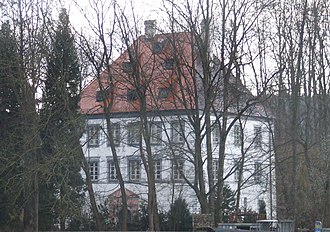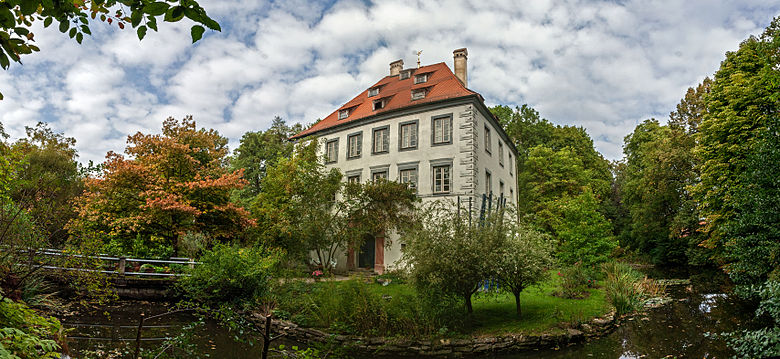Pilsach Castle
The Pilsach Castle is a small moated castle in the same community Pilsach , north of Neumarkt in the Upper Palatinate . It is located on a small island in a pond that is fed by the Pilsach, a small stream that gave the castle and town its name.
history
The castle was probably originally a medieval pond house, which was later expanded into a box-shaped building with a hipped roof via a residential tower . Since the beginning of the 12th century there was a manor house in Pilsach, which was under the rule of the Free von Wolfenstein. This castle stood on the summit of the Ottenberg rising immediately west of Pilsach . Only the remains of a square wall have been preserved from this complex, which today is only preserved as a castle stables .
The owners of the so-called "Lower Castle" were the mustard from Pilsach from the 14th century to the 17th century . In 1632 the castle was burned down by Gustav Adolf's troops, but was immediately rebuilt. In 1808 Margarete du Prel inherits the moated castle and brings it into her marriage to Baron Karl Ernst von Grießenbeck , an officer in royal Bavarian service. It remained in the family's possession until 1863, when the castle kept changing hands.
In 1919 the Höffner couple bought the moated castle and set up a foal breeding facility. Klara Höffner was a writer and called herself Klara Hofer. During renovation work in 1924, a room on a mezzanine was discovered, which she interpreted as a secret dungeon. Hofer published her discovery in a newspaper and linked it with the assumption that Kaspar Hauser could have spent his traditional childhood in this room without human contact. She addressed the Kaspar Hauser myth in 1924 with the book “The fate of a soul. The story of Kaspar Hauser taking into account the latest findings ”. Fritz Klee, an amateur researcher from Nuremberg, then visited the “dungeon”, described it and compared it with Kaspar Hauser's information about his dungeon. However, there is no historical evidence that Kaspar Hauser was detained in Pilsach. After the reconstruction of a staircase in 1982, the current owners of the castle presented a wooden, white wooden horse, which, according to an alleged dendrochronological study, is said to date from around 1820. In contrast, the historian and archive director Reinhard Heydenreuter , who also publishes in the field of scientific house research, emphasizes in the article by journalist Ulrich Rach ("Kaspar Hauser was probably never trapped in Pilsach. The legend is at the end. Old documents in the State Archives speak against common theses") in the Nuremberg News from December 7, 1996 that there is indeed a wooden horse that is associated with Kaspar Hauser, “ but the owners keep it under lock and key and do not have it examined for age. "
The castle now houses a gallery with a focus on glass art.
literature
- Herbert Rädle: Castles and fortress stables in the Neumarkt district . Published by the district of Neumarkt in der Oberpfalz, Neumarkt o. J., ISBN 3-920142-14-4 , pp. 84–86.
Web links
Coordinates: 49 ° 19 ′ 21 ″ N , 11 ° 30 ′ 19.1 ″ E



